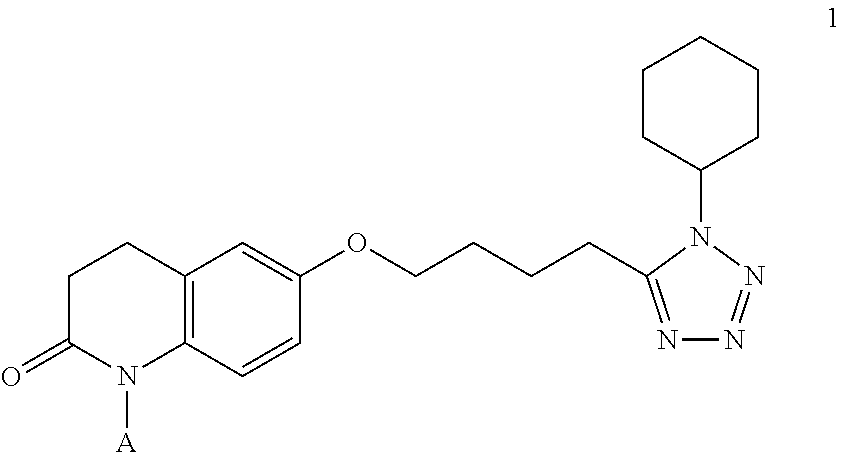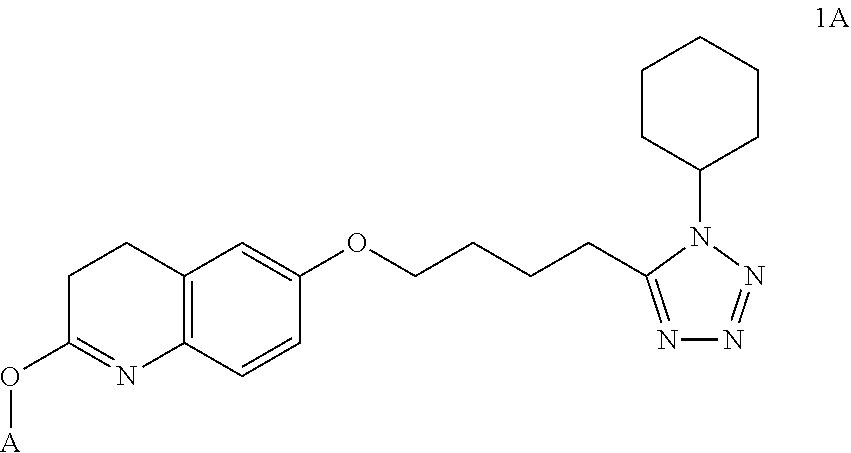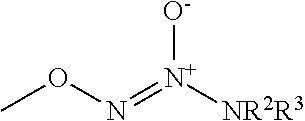Nitrate derivatives of cilostazol for the treatment of vascular and metabolic diseases
a technology of cilostazol and nitrate, which is applied in the field of nitrate derivatives of cilostazol, can solve the problems of short half-life, nitrate tolerance, and loss of part of the pharmacodynamic effect during chronic treatment and a three-time daily dosing regimen, and achieves superior vasodilating properties
- Summary
- Abstract
- Description
- Claims
- Application Information
AI Technical Summary
Benefits of technology
Problems solved by technology
Method used
Image
Examples
example 1
2-{2-(6-[4-(1-Cyclohexyl-1H-tetrazol-5-yl)butoxy]-2-oxo-3,4-dihydroquinolin-1H-yl)-2-oxoethyl}-propane-1,3-diyl acetone diketal (2)
[0052]
[0053]Equivalent amounts of 6-[4-(1-cyclohexyl-1H-tetrazol-5-yl)butoxy]-3,4-dihydroquinolin-2(1H)-one (cilostazol, formula 1, A=H, 554 mg, 1.5 mmol), 4-hydroxy-(3-hydroxymethyl)-butanoic acid dimethyl ketal (261 mg, 1.5 mmol), dicyclohexyl carbodiimide (DCC, 309 mg, 1.5 mmol) and 4-dimethylaminopyridine (DMAP, 183 mg, 1.5 mmol) are stirred in 5 ml CH2Cl2 for 3 days at room temperature. Dicyclohexylurea is filtered off, and the liquid evaporated and purified by chromatography (dichloromethane / diisopropylketone 97.5:2.5). The title compound 2 is obtained in 67% yield.
[0054]1H-NMR (400 MHz, CD3OD / CDCl3 9:1): δ 1.27-1.58 (m, 4H), 1.40 (s, 3H), 1.41 (s, 3H), 1.72-2.06 (m, 12H), 2.28-2.37 (m, 1H), 2.66-2.71 (m, 2H), 2.84-2.89 (m, 2H), 3.01 (t, J=7.6 Hz, 2H), 3.05 (d, J=6.7 Hz, 2H), 3.71 (dd, J=7.2, 11.8 Hz, 2H), 3.99-4.07 (m, 2H), 4.31-4.40 (m, 1H), 6.78...
example 2
1-[4-Hydroxy-3-(hydroxymethyl)butanoyl]-6-[4-(1-cyclohexyl-1H-tetrazol-5-yl)butoxy]-3,4-dihydroquinolin-2(1H)-one (3)
[0055]
[0056]A mixture of 5 mmol 2-{2-(6-[4-(1-cyclohexyl-1H-tetrazol-5-yl)butoxy]-2-oxo-3,4-dihydroquinolin-1H-yl)-2-oxoethyl}-propane-1,3-diyl acetone diketal (2, Example 1) and 0.10 g FeCl3—SiO2 reagent in 20 mL CHCl3 is stirred at room temperature. The reaction is monitored by TLC. After completion of the ketal cleavage, the mixture is filtered, and the filtrate concentrated under reduced pressure. The product is purified by flash chromatography.
example 3
1-[4-Bromo-3-(bromomethyl)butanoyl]-6-[4-(1-cyclohexyl-1H-tetrazol-5-yl)butoxy]-3,4-dihydroquinolin-2(1H)-one (4)
[0057]
[0058]To a solution of 6-[4-(1-cyclohexyl-1H-tetrazol-5-yl)butoxy]-3,4-dihydroquinolin-2(1H)-one (cilostazol, 1, A=H, 2.0 g, 3.50 mmol), N,N-dimethylaminopyridine (0.043 g, 0.35 mmol) and triethylamine (0.5 ml, 0.35 mmol) in THF (100 mL) at 0° C. and under nitrogen, a solution of 4-bromo-3-(bromomethyl)butanoyl chloride (0.97 g, 3.50 mmol) in THF (5 mL) is slowly added and the reaction mixture stirred at room temperature for 2 hours. Then it is partitioned between ethyl acetate and phosphate buffer (pH=3) and extracted with ethyl acetate (3×25 mL). The organic phase is dried over Na2SO4 and concentrated. The crude material is purified by flash chromatography (CH2Cl2 / acetone 7:3).
PUM
| Property | Measurement | Unit |
|---|---|---|
| Current | aaaaa | aaaaa |
| Composition | aaaaa | aaaaa |
Abstract
Description
Claims
Application Information
 Login to View More
Login to View More - R&D
- Intellectual Property
- Life Sciences
- Materials
- Tech Scout
- Unparalleled Data Quality
- Higher Quality Content
- 60% Fewer Hallucinations
Browse by: Latest US Patents, China's latest patents, Technical Efficacy Thesaurus, Application Domain, Technology Topic, Popular Technical Reports.
© 2025 PatSnap. All rights reserved.Legal|Privacy policy|Modern Slavery Act Transparency Statement|Sitemap|About US| Contact US: help@patsnap.com



